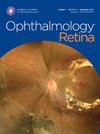Morphologic Stages of Full-Thickness Macular Hole on Spectral-Domain OCT
IF 4.4
Q1 OPHTHALMOLOGY
引用次数: 0
Abstract
Objective
To describe the sequential morphological changes of the outer retina after full-thickness macular hole (FTMH) formation utilizing a novel, objective staging system based on OCT, and to determine its association with baseline visual acuity, duration of symptoms, and postoperative visual acuity at 3 months.
Design
Retrospective, observational, multicenter study.
Participants
Patients with idiopathic FTMH presenting to St. Michael’s Hospital, Toronto, Canada, and Retina Consultants of Texas, Houston, Texas from 2009 to 2022.
Methods
The medical charts of 1000 patients with FTMH were reviewed, and those with ≥2 preoperative spectral-domain OCTs (SD-OCTs) were analyzed. A staging system was developed by assessing outer retinal morphology on successive SD-OCT central foveal scans.
Main Outcome Measures
Sequential outer retinal morphological changes with SD-OCT over time and their association with baseline visual acuity, duration of symptoms, and postoperative functional outcomes.
Results
Fifty-two eyes of 52 patients with a mean age of 65.4 ± 8.4 years were included. Sequential outer retinal morphologic changes at the FTMH borders occurred in 4 distinct and reproducible stages: stage A, separation of the neurosensory retina from the retinal pigment epithelium with the well-defined external limiting membrane (ELM), ellipsoid zone (EZ), and interdigitation zone (4/52, 7.7%); stage B, thickening of the EZ (27/52, 52.0%); stage C, patchy (moth-eaten) photoreceptor loss (16/52, 30.7%); and stage D, severe or complete loss of inner and outer segments and bare ELM (5/52, 9.6%). When assessing the preoperative OCT scans closest to the time of surgery, over a mean follow-up period of 288.9 ± 350.4 days (range, 5–1841), 28.85% (15/52) of eyes were in stage B, 28.85% (15/52) were in stage C, and 42.3% (22/52) were in stage D. There was a statistically significant association between increasing stage at baseline and longer duration of macular hole symptoms (P = 0.032) and worse visual acuity at baseline (P < 0.001). Additionally, patients presenting with stages B and C at the time point closest to surgery had better visual acuity outcomes 3 months postoperatively than those with stage D (P = 0.04).
Conclusions
This SD-OCT staging system describes the sequential in vivo morphologic changes after FTMH formation, providing a novel imaging biomarker.
Financial Disclosure(s)
Proprietary or commercial disclosure may be found in the Footnotes and Disclosures at the end of this article.
光谱域光学相干断层扫描显示的全厚黄斑孔形态学阶段。
目的利用基于光学相干断层扫描(OCT)的新型客观分期系统,描述全厚黄斑孔形成后外视网膜的连续形态变化,并确定其与基线视力、症状持续时间和术后3个月视力的关系:设计:回顾性、观察性、多中心研究:2009-2022年期间在加拿大多伦多圣迈克尔医院和美国休斯敦德克萨斯州视网膜顾问公司就诊的特发性全厚黄斑孔(FTMH)患者:方法:对 1000 名 FTMH 患者的病历进行了审查,并对至少进行过两次术前 SD-OCT 检查的患者进行了分析。通过评估连续SD-OCT中心眼窝扫描的视网膜外层形态,建立了一套分期系统:主要结果指标:SD-OCT视网膜外层形态随时间的连续变化及其与基线视力、症状持续时间和术后功能结果的关系:共纳入 52 名患者的 52 只眼睛,平均年龄为 65.4 ± 8.4 岁。FTMH 边界处视网膜外层形态的连续变化分为以下 4 个不同且可重复的阶段:A期:神经感觉视网膜与RPE分离,外缘膜(ELM)、椭圆体区(EZ)和连接区(IDZ)清晰可见(4/52,7.6%);B期:EZ增厚(27/52,51.9%);C期:斑片状(虫蛀状)感光体缺失(16/52,30.7%);D期:IS和OS严重或完全缺失和/或ELM裸露(5/52,9.6%)。当评估最接近手术时间的术前 OCT 扫描结果时,在平均 288.9 天(SD 350.4,[5 -1841])的随访期内,28.8%(15/52)的眼睛处于 B 期,28.8%(15/52)处于 C 期,42.3%(22/52)处于 D 期:这一 SD-OCT 分期系统描述了 FTMH 形成后体内形态的连续变化,提供了一种新的成像生物标志物。
本文章由计算机程序翻译,如有差异,请以英文原文为准。
求助全文
约1分钟内获得全文
求助全文

 求助内容:
求助内容: 应助结果提醒方式:
应助结果提醒方式:


